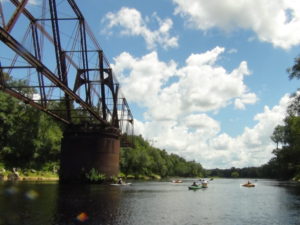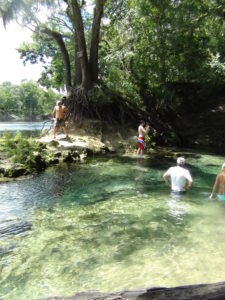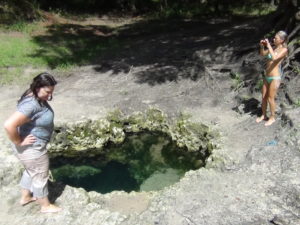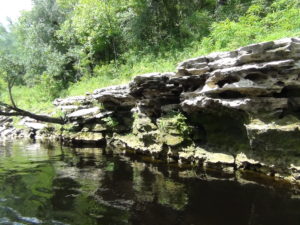Group size: 1 – 24 paddlers
Trip time: 3 – 4 hours
Skill level: Great for beginners and experts alike
Trip time: 3 – 4 hours
Skill level: Great for beginners and experts alike
The meeting place for this trip is on the Suwannee, about 1.5 hours NW of Gainesville.
Description
There are few places, in Florida or elsewhere, where you can find as many beautiful and unique springs as are found along the middle Suwannee River. On this trip, we’ll visit Telford, Bathtub, Convict, Running, Royal and Mearson springs.
 This is a relatively wide section of the Suwannee, averaging 300 – 400 feet across, that flows lazily in long, sweeping curves. Stained dark brown with tannins, much of it having come from the swampy headwaters of the Okefenokee swamp, contrast sharply with sandy white beaches and sloping bluffs. Perched above the river bank and stretching unseen for miles in all directions, mixed forests of pine and oak dominate the setting. It’s a higher, drier terrain than we experience on our “swampier” rivers, with nice, expansive vistas – plenty of Kodak moments.
This is a relatively wide section of the Suwannee, averaging 300 – 400 feet across, that flows lazily in long, sweeping curves. Stained dark brown with tannins, much of it having come from the swampy headwaters of the Okefenokee swamp, contrast sharply with sandy white beaches and sloping bluffs. Perched above the river bank and stretching unseen for miles in all directions, mixed forests of pine and oak dominate the setting. It’s a higher, drier terrain than we experience on our “swampier” rivers, with nice, expansive vistas – plenty of Kodak moments.The width of this section can make it sunny and hot or breezy at times. It’s a fairly long stretch too (about 11 miles) and usually takes us about 4.5 – 5 hours, including swim and lunch stops at the springs.
Wildlife
At this time of year, Middle Suwannee is the stomping grounds (or rather, splashing grounds) of the amazing Gulf sturgeon. Unlike some w ildlife encounters, spotting sturgeons takes no skill at all. Just keep your eye trained to the open water for a few moments and you’ll likely see a glistening, 6 – 7 foot long torpedo launch into the air. Then, with a grace that defies it’s 80 – 90 pounds (the largest are nearly 200 pounds), and the joie de vivre of a sparrow, it arches through the air, spinning and gyrating in wild celebration of it’s momentary freedom, before plunging back into the river.
ildlife encounters, spotting sturgeons takes no skill at all. Just keep your eye trained to the open water for a few moments and you’ll likely see a glistening, 6 – 7 foot long torpedo launch into the air. Then, with a grace that defies it’s 80 – 90 pounds (the largest are nearly 200 pounds), and the joie de vivre of a sparrow, it arches through the air, spinning and gyrating in wild celebration of it’s momentary freedom, before plunging back into the river.
 ildlife encounters, spotting sturgeons takes no skill at all. Just keep your eye trained to the open water for a few moments and you’ll likely see a glistening, 6 – 7 foot long torpedo launch into the air. Then, with a grace that defies it’s 80 – 90 pounds (the largest are nearly 200 pounds), and the joie de vivre of a sparrow, it arches through the air, spinning and gyrating in wild celebration of it’s momentary freedom, before plunging back into the river.
ildlife encounters, spotting sturgeons takes no skill at all. Just keep your eye trained to the open water for a few moments and you’ll likely see a glistening, 6 – 7 foot long torpedo launch into the air. Then, with a grace that defies it’s 80 – 90 pounds (the largest are nearly 200 pounds), and the joie de vivre of a sparrow, it arches through the air, spinning and gyrating in wild celebration of it’s momentary freedom, before plunging back into the river.On average, we see a few dozen of these primitive fish on this trip during the spring and summer months. As with mullet, their reason for jumping is still a mystery. Theories include predator avoidanc e, gill cleaning and communication, but the verdict is still out. Their reason for coming here is better understood – they’re spawning. During this period, they are totally devoted to the business of reproduction. Even the basic function of eating is put on hold until they return to the open Gulf in the fall.
e, gill cleaning and communication, but the verdict is still out. Their reason for coming here is better understood – they’re spawning. During this period, they are totally devoted to the business of reproduction. Even the basic function of eating is put on hold until they return to the open Gulf in the fall.
 e, gill cleaning and communication, but the verdict is still out. Their reason for coming here is better understood – they’re spawning. During this period, they are totally devoted to the business of reproduction. Even the basic function of eating is put on hold until they return to the open Gulf in the fall.
e, gill cleaning and communication, but the verdict is still out. Their reason for coming here is better understood – they’re spawning. During this period, they are totally devoted to the business of reproduction. Even the basic function of eating is put on hold until they return to the open Gulf in the fall.In general, we see less wildlife on this part of the Suwannee than we are used to seeing on some of our other trips. Wading birds prefer shallower, marshier waters while upland species such as perching birds, woodpeckers and raptors are harder to spot in forest set so far back from the water.
Other animals that live along this section of the Suwannee include such upland species as deer, squirrels and wild hog. This is also within the range of the Florida black bear, though we have never seen one on this tour (in the past 20 years of leading these tours, we’ve seen 5 black bears–all of them on rivers  south of here). Beavers, live here too. Unlike the elusive bears, we do occasionally see one of these amazing mammals (largest native rodent in N. America). Because they are mostly nocturnal, sightings are rare. We’re more likely to see their handy work such as chewed branches, tree trunks and slides down the steep, sandy banks. It takes a skilled eye to discern them from the otter slides, but there are some subtle tell-tale signs. The most interesting beaver signs are the lodges. We know of several beaver lodges along the Suwannee. Your guide will point them out if you do a tour on a section where they’re located.
south of here). Beavers, live here too. Unlike the elusive bears, we do occasionally see one of these amazing mammals (largest native rodent in N. America). Because they are mostly nocturnal, sightings are rare. We’re more likely to see their handy work such as chewed branches, tree trunks and slides down the steep, sandy banks. It takes a skilled eye to discern them from the otter slides, but there are some subtle tell-tale signs. The most interesting beaver signs are the lodges. We know of several beaver lodges along the Suwannee. Your guide will point them out if you do a tour on a section where they’re located.
 south of here). Beavers, live here too. Unlike the elusive bears, we do occasionally see one of these amazing mammals (largest native rodent in N. America). Because they are mostly nocturnal, sightings are rare. We’re more likely to see their handy work such as chewed branches, tree trunks and slides down the steep, sandy banks. It takes a skilled eye to discern them from the otter slides, but there are some subtle tell-tale signs. The most interesting beaver signs are the lodges. We know of several beaver lodges along the Suwannee. Your guide will point them out if you do a tour on a section where they’re located.
south of here). Beavers, live here too. Unlike the elusive bears, we do occasionally see one of these amazing mammals (largest native rodent in N. America). Because they are mostly nocturnal, sightings are rare. We’re more likely to see their handy work such as chewed branches, tree trunks and slides down the steep, sandy banks. It takes a skilled eye to discern them from the otter slides, but there are some subtle tell-tale signs. The most interesting beaver signs are the lodges. We know of several beaver lodges along the Suwannee. Your guide will point them out if you do a tour on a section where they’re located.Difficulty
This tour goes one way, with the current, so it’s very leisurely paddle on calm water. We’re usually on the water for about 3 – 4 hours, so, as with all tours, be realistic when you consider your strength and stamina.

